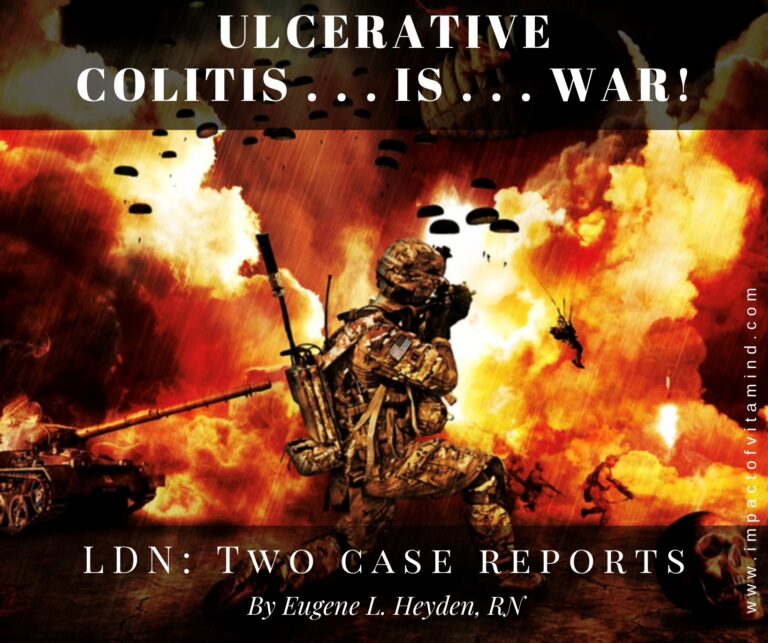LDN: Two case reports

By Eugene L. Heyden, RN
“Studies have shown that opioids have immunomodulatory activity, including modulation of the inflammatory response and healing and repair of tissues. Short-term blockade of opioid receptors leads to increased endogenous levels of opioids, which is the basis for naltrexone use in CD [Crohn’s disease].” ~ Kais, 2013
“Signaling through opioid receptors expressed by peripheral and intestinal immune cells has a significant impact on cytokine production and intestinal inflammation.” ~ Smith et al., 2011
There is a drug with that holds great promise in the battle against both Crohn’s and ulcerative colitis, known as naltrexone. When used strategically, and in a low dose, it has a profound effect on the immune system. It can reduce inflammation and allow remission to be achieved. And as a therapy, it can cost as little as $1.50 a day. Now that sounds almost too good to be true.
Naltrexone is a drug designed to occupy the opioid receptor and elicit a response. Conveniently, opioid receptors reside on a variety of immune cells and are actively involved in the inflammatory response. Naltrexone is unique, in that when taken at the usual (higher) dose, it produces a different response than when taken at a low dose. “Basic science evidence supports that concept by showing that low- and high-dose opioid antagonists have quite different impacts on the physiologic system.” (Younger et al., 2014)
Unlike other drugs in the IBD playbook, naltrexone is not a hammer you can beat an offending cytokine over the head with. It is a drug that can be strategically deployed to create a unique anti-inflammatory response. And this anti-inflammatory response, not an anti-inflammatory property of the drug itself, is what can come to the aid of the individual who is suffering from Crohn’s or suffering from ulcerative colitis. Intriguingly, this is a drug where less is more and more is less. So to create the anti-inflammatory response intended, naltrexone must be given in a low dose; hence the name, low-dose naltrexone (LDN). Let’s look a little deeper.
Mechanism of action
Mechanistically, LDN works by stimulating the activity of the opioid receptors that reside on the surface of various immune cells such as macrophages and T cells. But before this stimulating effect actually occurs, LDN creates “an intermittent blockade of the opioid receptor.” (Smith et al., 2007). This “intermittent blockade” appears to stimulate, as a countermeasure, the circulating levels of endorphins, our natural opioids that live to mate with this receptor. After the “blockade” wears off, the magic happens.
Besides stimulating the activity of the opioid receptor, as we have discussed, LDN appears to increase receptor numbers on the surface of immune cells, as well (Brown and Panksepp, 2008). And as a result, once the receptor blockade resolves, our natural opioids (endorphins), now present in greater amounts, rush in to fulfill the need. Subsequently, this “rebound effect” acts to upregulate the activity of the entire receptor/opioid system (Brown and Panksepp, 2008). Because this system is active in the cells of the immune system—and acts to block NF-ĸB activation and TNF-α production—people with inflammatory bowel disease are given a unique opportunity to improve.
And to see it in action, I have two case report to share.
Case report: Jessica
Jessica, age 18, had previously been diagnosed as having ulcerative colitis, with greater disease activity occurring in the rectum. After diagnosis, she was “treated initially with various mesalamine therapies (Asacol, Pentasa, Lialda) with intolerance due to increased rectal bleeding and severe headaches. Rectal mesalamine (Rowasa) was tried with minimal improvement.” Approximately 5 years after her initial diagnosis, Jessica was again evaluated for “5–10 loose, watery, bloody bowel movements.” Thankfully, she had no other symptoms of ulcerative colitis to report. But, still, some kind of therapy was in order.
“Patient requested minimal therapy; hence, biologics and immunomodulators were not an option. LDN was tried with dramatic results within 1 month: 1– 2 formed, non-bloody bowel movements per day and complete resolution of symptoms.” (Kais, 2013)
Case report: Evelyn
This case report (Weiksner et al., 2018) has apparently vanished from the internet, but since I have an old copy of the report from previous use, and it is from a reputable source, I feel comfortable sharing it with you.
Evelyn was diagnosed with ulcerative colitis at age 26. She is now 43, and not at all pleased with what is called “proctosigmoiditis.” I wouldn’t be pleased, either. Indeed, I’m pretty sure I would hate it. “Initially, the patient was treated with mesalamine (Asacol) and steroids (specifics unknown) with each flare. The patient self-discontinued mesalamine due to side effects.”
Eventually Evelyn found LDN, and in keeping with standard practice, LDN was prescribed in a dose of 4.5 mg, to be taken orally at bedtime. In response, within 6 months remission was achieved, and lasted for approximately five years under continual LDN use.
After the 5-year period of remission, Evelyn discontinued LDN, because of an opportunity to breastfeed. (I think she had a baby.) Well, that went well. Some little someone received the nutrition that he or she needed, and Evelyn’s ulcerative colitis remained in remission, thankfully for another four years and without the use of any therapy, including LDN. Her remission lasted an additional four years.
It would be nice to say that Evelyn lived happily ever after, but this cannot be said. Her ulcerative colitis returned after being in remission for 9 years. To address its return, mesalamine was initiated, but after three weeks it was discontinued due to a lack of improvement. And once again, LDN was resumed together with mesalamine. In short order, Evelyn responded favorably and mesalamine was discontinued.
The case report ends with Evelyn in remission. Happiness had returned. “Her regimen now consists of LDN 4.5 mg once daily, a multivitamin, folic acid, and a probiotic.”
Conclusion
In closing, I invite you to watch the following video, and please read the recommended case report below.
Recommended post (Click image to open)
References:
Brown N, Panksepp J. Low-dose naltrexone for disease prevention and quality of life. Medical hypotheses. 2009 Mar 1;72(3):333-7. Low-dose naltrexone for disease prevention and quality of life – ScienceDirect
Kais S. P-015 YI Low-Dose Naltrexone Therapy Improves Active Ulcerative Colitis. Inflammatory Bowel Diseases. 2013 Dec 1;19(suppl_1):S29-. https://academic.oup.com/ibdjournal/article/19/suppl_1/S29/4604998
Smith JP, Stock H, Bingaman S, Mauger D, Rogosnitzky M, Zagon IS. Low-dose naltrexone therapy improves active Crohn’s disease. Official journal of the American College of Gastroenterology| ACG. 2007 Apr 1;102(4):820-8. Low-Dose Naltrexone Therapy Improves Active Crohn’s Disease : Official journal of the American College of Gastroenterology | ACG (lww.com)
Smith JP, Bingaman SI, Ruggiero F, Mauger DT, Mukherjee A, McGovern CO, Zagon IS. Therapy with the opioid antagonist naltrexone promotes mucosal healing in active Crohn’s disease: a randomized placebo-controlled trial. Digestive diseases and sciences. 2011 Jul;56(7):2088-97. Therapy with the Opioid Antagonist Naltrexone Promotes Mucosal Healing in Active Crohn’s Disease: A Randomized Placebo-Controlled Trial | Digestive Diseases and Sciences (springer.com)
Weiksner S, Kheloussi S, Thomas, R. Low dose naltrexone for ulcerative colitis: two case reports. Poster presentation, Wickes University Nesbitt School of Pharmacy. 2018.
DISCLAIMER: This article is offered solely for informational purposes. The information contained therein and opinions expressed should be evaluated for accuracy and validity in the context of opposing data, new information, and the views and recommendations of a qualified healthcare professional, and not to be substituted for professional judgment and guidance or to provide a reason to neglect or delay appropriate medical care for self or for others. It is the reader, and reader only, who bears the responsibility for any actions that could be construed as being a response to the information presented. The statements and opinions expressed by the author have not been reviewed or approved by the FDA or by any other authoritative body, nor is the author endorsing any product or specific therapy mentioned. This article and the opinions contained therein are offered to the reader to broaden his or her understanding of the issues discussed and to help identify options that may be suitable for the individual to pursue, on behalf of self or others, under approval and direction of a qualified physician or medical team member. All questions of a medical nature which arise from reading this article should be directed at qualified health care professional. There are no guarantees that a suggested website and internal links are safe to visit or open or are currently available.
Copyright © 2024 Eugene L. Heyden, RN
All Rights Reserved

